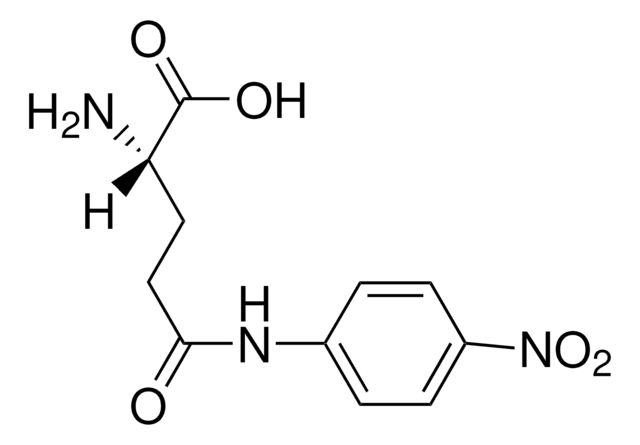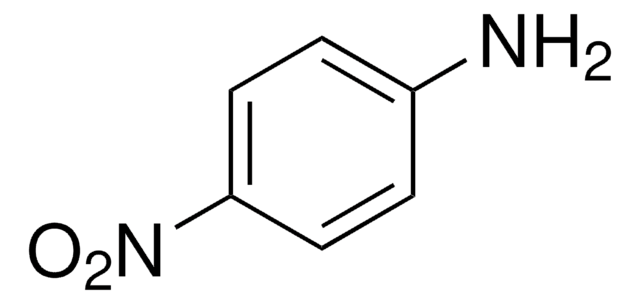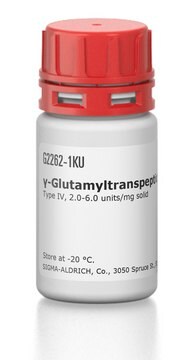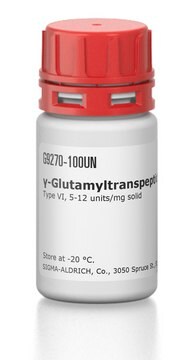G6133
L-Glutamic acid γ-(p-nitroanilide) hydrochloride
γ-glutamyl transpeptidase substrate
Synonym(s):
L-γ-Glutamyl-p-nitroanilide
Sign Into View Organizational & Contract Pricing
All Photos(4)
About This Item
Empirical Formula (Hill Notation):
C11H13N3O5 · HCl
CAS Number:
Molecular Weight:
303.70
EC Number:
MDL number:
UNSPSC Code:
12352204
PubChem Substance ID:
NACRES:
NA.83
Recommended Products
Quality Level
Assay
≥98% (HPLC)
form
powder
solubility
water: 5 mg/mL, clear, yellow
storage temp.
2-8°C
SMILES string
Cl.NC(CCC(=O)Nc1ccc(cc1)N(=O)=O)C(O)=O
InChI
1S/C11H13N3O5.ClH/c12-9(11(16)17)5-6-10(15)13-7-1-3-8(4-2-7)14(18)19;/h1-4,9H,5-6,12H2,(H,13,15)(H,16,17);1H
InChI key
OJEVFSFTVARWQX-UHFFFAOYSA-N
Application
L-Glutamic acid γ-(p-nitroanilide) hydrochloride has been used as a solute carrier family 1 member 5 (SLC1A5) inhibitor:
- or an inhibitor of the cell membrane glutamine transporter to study the effects of blocking glutamine uptake on esophageal adenocarcinoma (EACC) and thioredoxin-interacting protein (TXNIP)
- in glutamine ELISA assay to treat confluent differentiated uninfected human colonoid monolayer (HCM) in apical and basolateral compartments to study its effects
- to study its effect on SLC1A5_var-mediated mitochondrial glutamine transport inhibition
- to study its effects on cellular glutathione levels, cellular reactive oxygen species (ROS) levels, and mitochondrial ROS levels
Biochem/physiol Actions
L-Glutamyl-p-nitroanilide (GPNA) is commonly used to block the glutamine (Gln) transporter alanine-serine-cysteine transporter 2 (ASCT2). It can also inhibit sodium-dependent and independent amino acid transporters. GPNA, γ-glutamyltransferase (GGT) substrate plays a key role in the hydrolysis of its γ-glutamyl bond and the subsequent release of the chromogen, p-nitroaniline (PNA).
Substrates
Substrate for γ-glutamyl transpeptidase
Storage Class Code
11 - Combustible Solids
WGK
WGK 3
Flash Point(F)
Not applicable
Flash Point(C)
Not applicable
Personal Protective Equipment
dust mask type N95 (US), Eyeshields, Gloves
Choose from one of the most recent versions:
Already Own This Product?
Find documentation for the products that you have recently purchased in the Document Library.
Customers Also Viewed
Paul L Feingold et al.
Molecular cancer therapeutics, 17(9), 2013-2023 (2018-06-24)
In 2017, an estimated 17,000 individuals were diagnosed with esophageal adenocarcinoma (EAC), and less than 20% will survive 5 years. Positron emission tomography avidity is indicative of high glucose utilization and is nearly universal in EAC. TXNIP blocks glucose uptake
Alessandro Corti et al.
Scientific reports, 9(1), 891-891 (2019-01-31)
L-γ-Glutamyl-p-nitroanilide (GPNA) is widely used to inhibit the glutamine (Gln) transporter ASCT2, but recent studies have demonstrated that it is also able to inhibit other sodium-dependent and independent amino acid transporters. Moreover, GPNA is a well known substrate of the
Alessandro Corti et al.
Scientific reports, 9(1), 891-891 (2019-01-31)
L-γ-Glutamyl-p-nitroanilide (GPNA) is widely used to inhibit the glutamine (Gln) transporter ASCT2, but recent studies have demonstrated that it is also able to inhibit other sodium-dependent and independent amino acid transporters. Moreover, GPNA is a well known substrate of the
Long-Liu Lin et al.
Applied microbiology and biotechnology, 73(1), 103-112 (2006-07-20)
A truncated gene from Bacillus lichenifromis ATCC 27811 encoding a recombinant gamma-glutamyltranspeptidase (BLrGGT) was cloned into pQE-30 to generate pQE-BLGGT, and the overexpressed enzyme was purified from the crude extract of IPTG-induced E. coli M15 (pQE-BLGGT) to homogeneity by nickel-chelate
M Moriguchi et al.
Archives of microbiology, 144(1), 15-19 (1986-02-01)
Three gamma-glutamyltranspeptidase (enzymes I, II and III) were partially purified from the cell free extracts of the cultured mycelia of Morchella esculenta Fr. The molecular masses of enzymes were 155,000 (I), 219,000 (II) and 102,000 (III). All of them catalyzed
Our team of scientists has experience in all areas of research including Life Science, Material Science, Chemical Synthesis, Chromatography, Analytical and many others.
Contact Technical Service







